Our perspective and the assumptions and decisions that are triggered by that point-of-view, strongly influence how we perceive the world around us. In short, what we see often depends on how we look at it.
This classic drawing looks like a frog sitting on the edge of a pond…
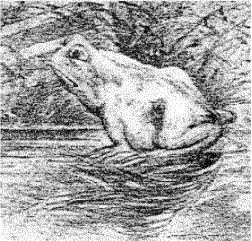 but rotate it ninety degrees and it turns into a horse’s head!
but rotate it ninety degrees and it turns into a horse’s head!
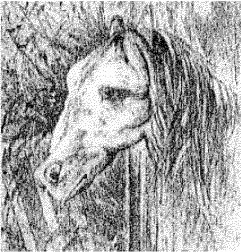 This horse/frog drawing comes from a generic internet source and I assume it is public domain.
This horse/frog drawing comes from a generic internet source and I assume it is public domain.If not please let me know, and if anyone knows the artist or original source I’d like to give credit.
We can all remember times when we’ve experienced this kind of perceptual flip-flop in real life, insisting one thing is correct only to realize in a flash that our underlying assumptions – and our conclusions – were wrong. It certainly comes up a lot in bird identification. A flash of what “could only be” a male Yellow-headed Blackbird resolves into a Common Grackle holding a corn chip; or a carefully-studied Western Sandpiper turns into a Dunlin when it walks next to a much smaller Least.
Clear photographic examples of this are rare, but one such example is this mysterious photo of an apparently black-faced bird taken in late September 2007 by an automatic Wingscapes birdcam and discussed on the Birdcouple blog, with most viewers suggesting either a Carolina Chickadee or a Common Redstart (a Eurasian species not previously recorded in North America).
We probably all look at this picture and assume, quite reasonably, that the bird is holding it’s head in a normal position looking to the left and slightly down. And in the image below I’ve zoomed in and taken the liberty of adding the outline of an eye in about the right position to fit this assumption. In this case the pattern of black face, pale crown, pinkish-buff underside, etc. is a pretty good match for Common Redstart. There are lots of details that are not quite right, some of which have been mentioned in comments with the original blog post. Many experienced birders will notice the details, or simply note that the location is very unlikely for Common Redstart, and will step back to look for another explanation. (If you think the eye looks like it isn’t in quite the right place, I can assure you that I moved it around in photoshop and this was the best placement I could find. The eye just doesn’t fit this way, which is another clue that the black pattern and head shape is not right for Redstart.)
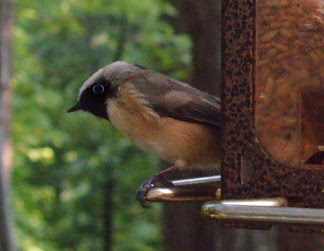
Below, again, I’ve taken the liberty of adding a dark spot, this time to show where I think the eye actually is (and a helpful arrow to point it out). I think the head is rotated ninety degrees and the bird is looking up at the sky with one eye, so we’re seeing the black throat, and the white band on the upper edge of the head is the “cheek”. With the eye in this position the bird’s head plumage is a perfect match for Carolina Chickadee. Other details also fit and give no reason to question the ID, and the species is common in the area where the photo was taken.
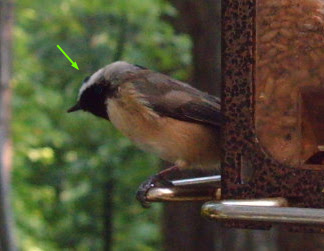 So I agree completely with the few respondents who have already suggested that this bird is a Carolina Chickadee with its head turned. This particular identification pitfall might never come up in field observations, when we would be able to see the bird move and quickly correct our error, but lots of similar things do happen under field conditions. This story demonstrates that there are nearly infinite possibilities for misidentification, and shows how one misleading glimpse can trigger assumptions that set us firmly onto the wrong path.
So I agree completely with the few respondents who have already suggested that this bird is a Carolina Chickadee with its head turned. This particular identification pitfall might never come up in field observations, when we would be able to see the bird move and quickly correct our error, but lots of similar things do happen under field conditions. This story demonstrates that there are nearly infinite possibilities for misidentification, and shows how one misleading glimpse can trigger assumptions that set us firmly onto the wrong path.


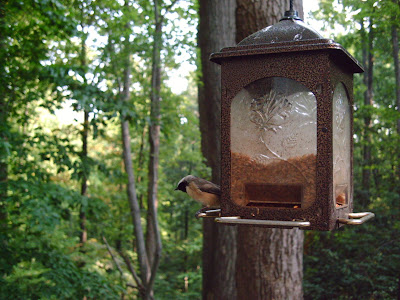
Thanks David. I had participated in the discussion and was in the Chickadee camp. I had originally thought that the camera had captured the blur of a moving head. Your illustration makes it very obvious as to what we are seeing.
This is a wonderful lesson on different kinds of perspectives! Thanks for showing us different ways of looking at our pictures!
That was very interesting! It just goes to prove that there are different ways of looking at pictures!
very interesting post David.
Just goes to show that the eye can be deceiving and further illustrates your last post about seeing a “shrike” in NJ that wasn’t.
Light and angle certainly play a part in making ID difficult.
I remember being stumped for an instant by a Starling that was sitting so that the light hit it just right. So instead of a starling, I was tricked into thinking I was looking at a very colorful rarity. Then the light changed and the bird once again became a plain old starling.
There was another instance when I was in Cape May NJ. I was birding down by the observatory and
through the leaves, I spotted what I was sure must be a Blackburnian warbler. A good bird for the area. A few seconds later, one of the many Parulas we had found that day popped into an opening, quickly proving me wrong.
Thanks for the post!
Happy Birding! –CW
The SW WI birder
http://swallowtailedkite.blogspot.com/
I’m thrilled to have come upon your site!
It is so interesting to hear the thought processes behind “mysterious” bird sightings, and encouraging to recognize that even a professional with your history wrestles with an answer, at times.
And, I love the sketches dotting the lines–lovely.
Very, very cool stuff! I”m so glad you’re blogging. Welcome to the machine!
Would love to compare notes with you on your PA. experience…
How interesting! I made the same assumption the masses made regarding head position. Great lesson. thank you.